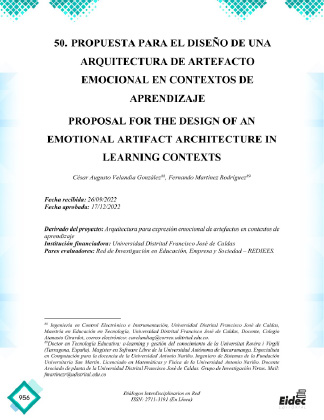L. PROPOSAL FOR THE DESIGN OF A ARTIFACT ARCHITECTURE EMOTIONAL IN CONTEXTS OF LEARNING
##plugins.themes.bootstrap3.article.main##
Abstract
This paper aims to show the process of designing an architecture for
artificial physical artifacts that demonstrate emotions and are used in environments
educational for learning. This presentation allows to socialize the progress of the thesis
Architecture for the Emotional Expression of Artifacts in Learning Contexts, which
serves as degree work for the Master of Education in Technology of the University
Francisco José de Caldas District. The objective of the research of this thesis is to analyze
how an architecture of emotional expression for artifacts affects the learning of a
person. The methodology used in this research is based on design under an approach
quasi-experimental quantitative. In the design stage, the results were a review
of related literature that would allow establishing to what extent progress has been made in the
elaboration of artifacts endowed with artificial emotions. Consequently, it
established characteristics of people, animals, and objects that were recognizable as
expression of emotions. One consideration that was taken into account is that the device does not
was necessarily anthropomorphic, since it is sought that architecture can be applied
in tools of different shapes. As a consequence of this, an artifact was produced in
cube-shaped, which had several prototypes and versions. These designs allow the
application of an emotional architecture to physical tools in a learning process.
Download Statistics
##plugins.themes.bootstrap3.article.details##
Architecture, Emotions, Learning, Artifact, Design.
YOLO, a creativity-stimulating robot for children. HardwareX, 6, e00074.
Breazeal, C., Kidd, C. D., Thomaz, A. L., Hoffman, G., & Berlin, M. (2005, August).
Effects of nonverbal communication on efficiency and robustness in human-robot teamwork.
In 2005 IEEE/RSJ international conference on intelligent robots and systems (pp. 708-713).
IEEE.
de Benito Crosetti, B., & Ibáñez, J. M. S. (2016). La investigación basada en diseño
en Tecnología Educativa. Revista Interuniversitaria de Investigación en Tecnología
Educativa.
Ekman, P. (1999). Facial expressions. Handbook of cognition and emotion, 16(301),
e320.
Håkansson, G., & Westander, J. (2013). Communication in humans and other
animals. Amsterdam: John Benjamins Publishing Company.
Hoffman, G., & Ju, W. (2014). Designing robots with movement in mind. Journal of
Human-Robot Interaction, 3(1), 91-122.
Stebbins, G. (1886). Delsarte system of dramatic expression. ES Werner.
Immordino‐Yang, M. H., & Damasio, A. (2007). We feel, therefore we learn: The
relevance of affective and social neuroscience to education. Mind, brain, and education, 1(1),
3-10.
Kort, B., Reilly, R., & Picard, R. W. (2001, August). An affective model of interplay
between emotions and learning: Reengineering educational pedagogy-building a learning
companion. In Proceedings IEEE international conference on advanced learning
technologies (pp. 43-46). IEEE.
Kort, B., & Reilly, R. (2002). Analytical models of emotions, learning and
relationships: towards an affect-sensitive cognitive machine. In Conference on virtual worlds
and simulation (VWSim 2002) (pp. 1-15).
Valderrama Higuera, E. A. (2020) Un estudio exploratorio sobre la conducta
emocional del robot navs en contextos educativos. Wood, D., Bruner, J. S., & Ross, G. (1976). The role of tutoring in problem
solving. Child Psychology & Psychiatry & Allied Disciplines.





